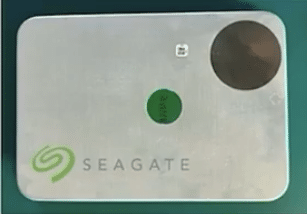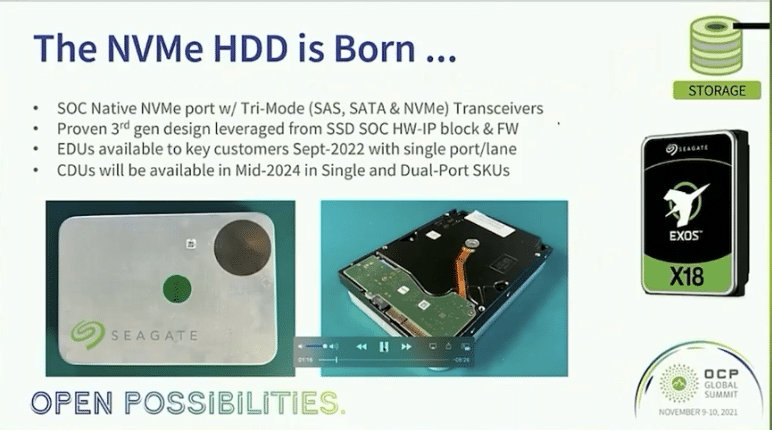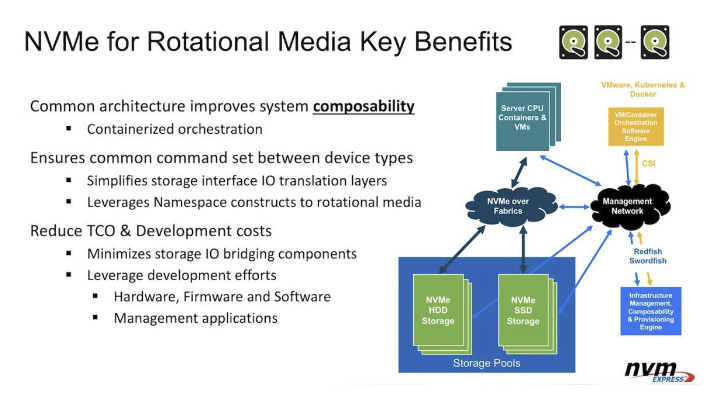When you think NVMe, SSDs are the first thing that comes to mind. And for good reason, the NVMe interface changed the game when it comes to flash latency and throughput. In June, NVM Express, the non-profit organization behind NVMe specifications, released solutions that include support for Hard Disk Drives (HDDs). Additionally, the specifications facilitate the emerging NVMe device ecosystem, including enterprise and client solid-state drives (SSDs), removable cards, and compute accelerators.
When you think NVMe, SSDs are the first thing that comes to mind. And for good reason, the NVMe interface changed the game when it comes to flash latency and throughput. In June, NVM Express, the non-profit organization behind NVMe specifications, released solutions that include support for Hard Disk Drives (HDDs). Additionally, the specifications facilitate the emerging NVMe device ecosystem, including enterprise and client solid-state drives (SSDs), removable cards, and compute accelerators.

NVMe HDDs? Really?
To add validity to the development of NVMe HDD, Seagate demonstrated the first hard drive with native NVMe support during the 2021 Open Compute Project Summit. Seagate’s demo version has a tri-band controller supporting SATA, SAS, and NVMe protocols through a native NVMe interface without the need for a bridge.
Seagate demonstrated the NVMe HDD in a 2U server with 12-3.5″ NVMe HDDs connected to a PCIe switch. The version in the demo used PCIe 3.0, but commercial variants should support PCIe 4.0.

In addition to the potential for larger capacity drives, HDDs and SSDs in servers would use the same connections simplifying server hardware and potentially delivering a lower cost of ownership, offering energy savings, scalability, and performance improvements.

Early shipments of NVMe HDD technology are expected to ship to select customers in late 2022. This announcement is excellent news for next-generation data centers that rely on shared and multi-tenant architectures ushering in the transition to NVMe over PCIe architecture.
So, those hard drives sitting in the warehouse will not have a place in the new architecture. To get the most out of NVMe 2.0, HDDs will need a PCIe interface. Although PCIe drives are not available in a spinning disk, the technology is advancing quickly. Solid State Drive pricing continues to drop while capacity increases. However, it would be a stretch to assume SSDs will get to the current $/TB of the more affordable HDDs anytime soon. That is the sweet spot for hard disk technology.
In the Meantime
Consider building out storage farms using both SSD and HDD. There are benefits to this hybrid model. Map critical apps and data to initiate from the SSD array with long-term backups mapped to the HDD arrays. This design is a popular alternative to building out disk farms.
Looking for something a little sooner, take a look at multi-actuator hard drives. StorageReview took a look at the Seagate Exos 2X14 HDD in May and found impressive results. The current model is a 14TB drive with dual-actuators. The drive is split into two 7TB logical units but offers performance levels that rival SATA SSD. Although not in full production, this drive is on the books.
Engage with StorageReview
Newsletter | YouTube | LinkedIn | Instagram | Twitter | Facebook | TikTok | RSS Feed
